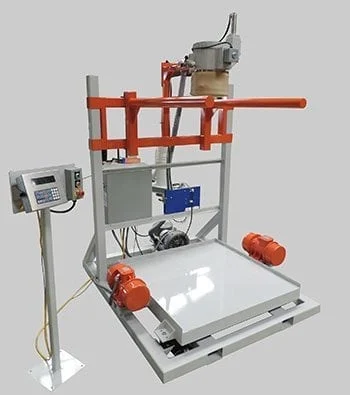Many cement plant operators turn to us because they’re experiencing difficulty achieving high weight accuracy and high throughput for bulk bag filling. The complaint is the same: The bag filler isn’t doing the job.
In these cases, the first question I ask has nothing to do with the bag filler brand or type. I ask this: “Are you using a slide gate feed system?” There’s a good reason for my question because since 1978 CBE has been manufacturing and servicing bagging equipment for the cement industry. Over the years we’ve learned what works best for cement plants. And that’s why I first asked about the slide gate.
Why Slidegates Appear To Be The Right Choice
A slide gate is a simple and commonly used device for controlling the flow of gravity-fed material from a hopper into a bulk bag filling machine. The slide gate’s opening size is manually set by the operator for the desired flow of material. Simple and fast. No wonder cement plants think, at first, that a gravity-fed slide gate system is perfect for their operation.
A slide gate makes the right choice if speed is all that matters. However, speed comes at a cost of accuracy, consistency, and cleanliness. The faster you load the bag, the less control you will have and the more these other things will suffer.
Compelling Reason #1: Why Slidegates Should NOT Be Used In Cement Plants – Accuracy
Weight accuracy is equally important to speed. In fact, in high-volume operations, weight accuracy is where money is made or lost. Unfortunately, slide gates are not the best choice for accurate bagging of Portland cement. This is because the density of Portland cement fluctuates during production (like most granular powders do).
The density of the material in the holding hopper changes and is less or more fluid depending on the amount that the material is fluidized. As the density varies, so do the flow characteristics of the material resulting in off-weight bags. As the material flows through a gravity gate depending on how aerated it is, its density could be anywhere between 70 Lbs./CuFt (if it is aerated) and 94 Lbs/CuFt (if it is settled or packed). Without a more measured and controllable method of feeding material into the bagging machine, achieving acceptable weight accuracy will not be possible.
Compelling Reason #2: Why Cement Plants Should Avoid Slidegates – Dust
There’s another issue with slide gate controls – dust. Rapid filling by gravity feed creates a sudden, large amount of displaced air that can expel a quantity of material and dust from the bag, briefly overtaking the capabilities of the dust collection system.
Any plant that insists on using slidegates to control the gravity flow of Portland cement to a bulk bag filler must invest in proper product conditioning and dust collection. However, even with these systems in place, the equipment operator will find it necessary to manually adjust the slide gate during the production run as the characteristics of the material change due to changes in humidity and density.
Alternative Metering Systems for Bagging Cement
As I have explained, slide gates can be problematic in any cement plant interested in weight accuracy and speed for filling bulk bags. Therefore, we recommend a positive feeder such as an auger or a rotary airlock. Either of these feed systems is an effective solution for Portland and masonry cement bagging.
When bulk bag fillers are required, rather than valve bag fillers, we frequently specify our Model 510 and Model 520 Bulk Bag Fillers equipped with an auger-feed or rotary airlock. Either model has a capacity to handle bag weights from 1,000 to 4,400 pounds at up to 25 bags per hour.
If weight accuracy and/or improving bag fill cleanliness is important, I recommend you consider either upgrading your existing bulk bag filling system with a positive feed system or making sure that your next system includes a positive feed system.


Recent Comments